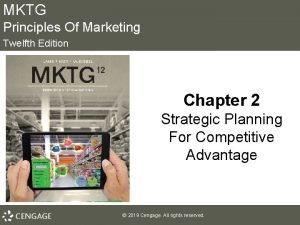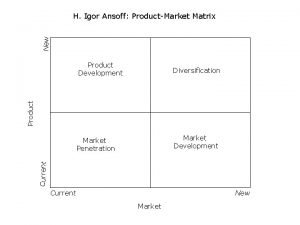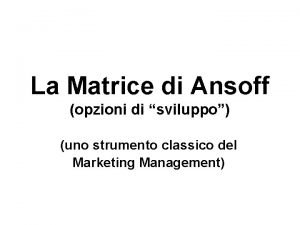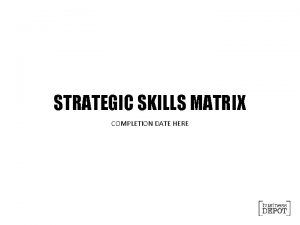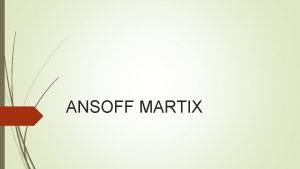ANSOFF MATRIX The Ansoff Matrix is a strategic








![§ Isolation challenges[edit] § Used by itself, the Ansoff matrix could be misleading. It § Isolation challenges[edit] § Used by itself, the Ansoff matrix could be misleading. It](https://slidetodoc.com/presentation_image_h/897c3b065e0a7becbb72a9049f77bda4/image-9.jpg)

- Slides: 10

ANSOFF MATRIX

§ The Ansoff Matrix is a strategic planning tool that MEANING: provides a framework to help executives, senior managers, and marketers devise strategies for future growth. [1][2] It is named after Russian American Igor Ansoff, an applied mathematician and business manager, who created the concept.

§ In market penetration strategy, the organization tries to grow using its Market penetration existing offerings (products and services) in existing markets. In other words, it tries to increase its market share in current market scenario. This involves increasing market share within existing market segments. This can be achieved by selling more products or services to established customers or by finding new customers within existing markets. Here, the company seeks increased sales for its present products in its present markets through more aggressive promotion and distribution. [citation needed] § This can be accomplished by: § Price decrease § Increase in promotion and distribution support § Acquisition of a rival in the same market § Modest product refinements § This is the least risky growth option

§ In market development strategy, a firm tries to expand into new markets (geographies, countries etc. ) using its existing offerings and also, with minimal product/services development. Market development § This can be accomplished by: § Different customer segments § Industrial buyers for a good that was previously sold only to the households; § New areas or regions of the country § Foreign markets.

§ This strategy is more likely to be successful where: § The firm has a unique product technology it can leverage in the new market § It benefits from economies of scale if it increases output § The new market is not too different from the one it has experience of § The buyers in the market are intrinsically profitable. § This additional quadrant move increases uncertainty and thus increases the risk further.

§ In product development strategy, a company tries to create new products and services targeted at its existing markets to achieve growth. This involves extending the product range available to the firm's existing markets. These products may be obtained by: Product development § Investment in research and development of additional products; § Acquisition of rights to produce someone else's product; § Buying in the product and “badging” it as one’s own brand; § Joint development with ownership of another company who need access to the firm's distribution channels or brands. § This also consists of one quadrant move so is riskier than Market penetration and a similar risk as Market development.

§ In diversification an organization tries to grow its market share by introducing new offerings in new markets. It is the most risky strategy because both product and market development is required. § Related Diversification— there is relationship and, therefore, Diversification potential synergy, between the firms in existing business and the new product/market space. Concentric diversification, and (b) Vertical integration. [clarification needed] § Unrelated Diversification: This is otherwise termed conglomerate growth because the resulting corporation is a conglomerate, i. e. a collection of businesses without any relationship to one another. A strategy for company growth by starting up or acquiring businesses outside the company’s current products and markets. § Diversification consists of two quadrant moves so is deemed the riskiest growth option.

§ The Ansoff Matrix is a useful tool for organizations USES OF ANSOFF MATRIX wanting to identify and explore their growth options. Although the risk varies between quadrants, with Diversification being the riskiest, it can be argued that if an organization diversifies its offering successfully into multiple unrelated markets then, in fact, its overall risk portfolio is lowered.
![Isolation challengesedit Used by itself the Ansoff matrix could be misleading It § Isolation challenges[edit] § Used by itself, the Ansoff matrix could be misleading. It](https://slidetodoc.com/presentation_image_h/897c3b065e0a7becbb72a9049f77bda4/image-9.jpg)
§ Isolation challenges[edit] § Used by itself, the Ansoff matrix could be misleading. It does not take into account the activities of competitors and the ability for competitors to counter moves into other industries. It also fails to consider the challenges and risks of changes to business-as-usual activities. An organization hoping to move into new markets or create new products (or both) must consider whether they possess transferable skills, flexible structures, and agreeable stakeholders. Criticisms § Logical consistency challenges[edit] § The logic of the Ansoff matrix has been questioned. The logical issues pertain to interpretations about newness. If one assumes a new product really is new to the firm, in many cases a new product will simultaneously take the firm into a new, unfamiliar market. In that case, one of the Ansoff quadrants, diversification, is redundant. Alternatively, if a new product does not necessarily take the firm into a new market, then the combination of new products into new markets does not always equate to diversification, in the sense of venturing into a completely unknown business. [4]

§ The Ansoff matrix has proved useful, and with the use of CONCLUSION real life evidence, it accurately depicts the most effective strategies that businesses could use depending on their market and customer segment. Though the four strategies apply differently to companies depending on their market and product intentions, it also depends hugely on firm specific capabilities such as brand image and research capabilities. Organisations seeking to adopt its usage when seeking strategic direction should therefore do so in due consideration of their firm specific strengths and benefits and how these could also be applied to the products being offered and markets being targeted.
